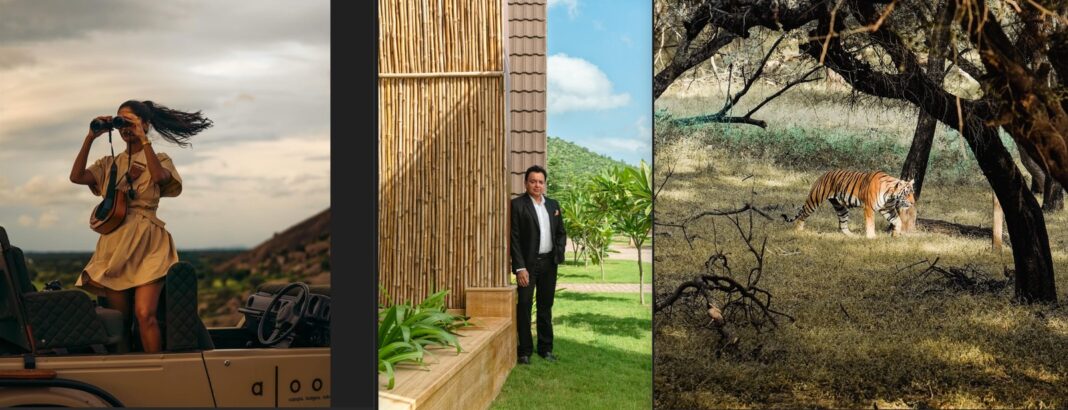A new trend that lures people away from metropolitan amenities and into the heart of untamed wilderness is growing amid the restless beat of city life. Properties that focus on wildlife are becoming more and more well-liked because they provide visitors the chance to fully experience the untainted splendor of the natural world. These accommodations, which range from opulent tents on African plains to secluded cottages deep in Indian jungles, offer a genuine getaway where the sound of faraway wildlife rustling and birds chirping in the morning silence takes the place of blaring alarm clocks and traffic. More and more people today are searching for locations where the excitement of unspoiled, raw landscapes and the comforts of contemporary life coexist together in order to experience a closer connection to nature. In this leisurely read, let us tell you how nature itself becomes the experience, bringing adventure, peace and the kind of amazement that only the wild can inspire!
“The best way to follow this new trend is to adopt sustainable habits that reduce our environmental impact and improve the surrounding natural ecosystems! The first step in preventing development from upsetting the native flora and fauna is to carefully manage land use. Give top priority to the usage of environmentally friendly building materials and install energy-saving equipment. Naturally, why not work with regional conservation organisations to save wildlife habitats and guarantee that activities interact sustainably with the surrounding ecosystems? Isn’t this a smart move? Encouraging environmentally sensitive visitor experiences, such as wildlife safaris guided by knowledgeable naturalists, that aim to increase understanding and reverence for the surrounding ecosystem—pperhaps is an additional concept to consider,” communicates the Managing Director of Ananta Hotels & Resorts! Because one of the most noteworthy aspects of the forward-thinking initiatives is the creation of a serene and peaceful oasis at Ajabgarh, carefully crafted to harmonise perfectly with the stunning natural surroundings of the Sariska Tiger Reserve. This innovative project not only showcases a deep understanding of the importance of environmental balance but also offers a unique opportunity to experience the beauty and tranquility of this breathtaking reserve. By blending seamlessly into the existing landscape, the oasis enhances the natural charm of the area, making it a fascinating destination to explore and learn about the delicate ecosystem.
To minimise the negative effects of wildlife tourism, a meticulously responsible strategy is crucial in designing eco-friendly properties. This entails constructing facilities with minimal disturbance to surrounding natural habitats. Prior to development, comprehensive environmental impact assessments must be conducted to guarantee seamless integration with the local ecosystem. Wildlife excursions should be led by expert naturalists who instruct visitors on responsible tourism practices, fostering respect for the environment and wildlife. Furthermore, collaborating with local conservation initiatives and promoting sustainable methods—such as waste reduction, water conservation and renewable energy utilisation – ensures that these properties contribute positively to the delicate environments rather than causing harm. “ India’s breathtaking wildlife and diverse landscapes have long been a profound source of inspiration for us. Driven by this passion, we sought to share these natural wonders with others through unforgettable, up-close experiences. By combining our hospitality passion with environmental stewardship, wildlife tourism emerged as the perfect synergy. The wildlife-focused revolution aims to inspire a deeper appreciation and reverence for nature while offering immersive and unique adventures. Furthermore, we recognised wildlife tourism as a catalyst for positive change in local communities!” recognises our interviewee, who is focusing on this “wild” innovation to carry on his father’s legacy.
The preservation of the natural balance is crucial and particular caution must be used when developing land close to delicate habitats like the Sariska Tiger Reserve. To ensure compatibility with the native flora and animals, these teams employ a conscientious and sustainable approach! “During one of the safaris, patrons had the unique opportunity to see a mother tiger and her children in a waterhole. This is an exclusive story I often tell! They were forever changed by this enchanted moment because they were able to appreciate the beauty of wildlife and understand how crucial it is to preserve these magnificent animals and their natural habitat. The new buzz surrounding this type of tourism is due to the profoundly transformational experience that these unusual encounters, when paired with environmentally conscientious actions, give.” The crew is also working to safeguard the local Indian species known as the Great Indian Bustard, which is in grave risk of extinction! They support conservation programs targeted at saving this famous species, assist in raising awareness and contribute to habitat preservation efforts by collaborating with local wildlife authorities and conservation organisations.
These kinds of immersive experiences are becoming more and more popular. Additionally, there are guided wildlife photography tours that offer opportunities to take amazing pictures! Then, by allowing visitors to take part in conservation and research initiatives, citizen science programs promote a closer bond with the natural world! Overall, this tourism offers genuine cultural experiences and empowers indigenous people, so why not?




